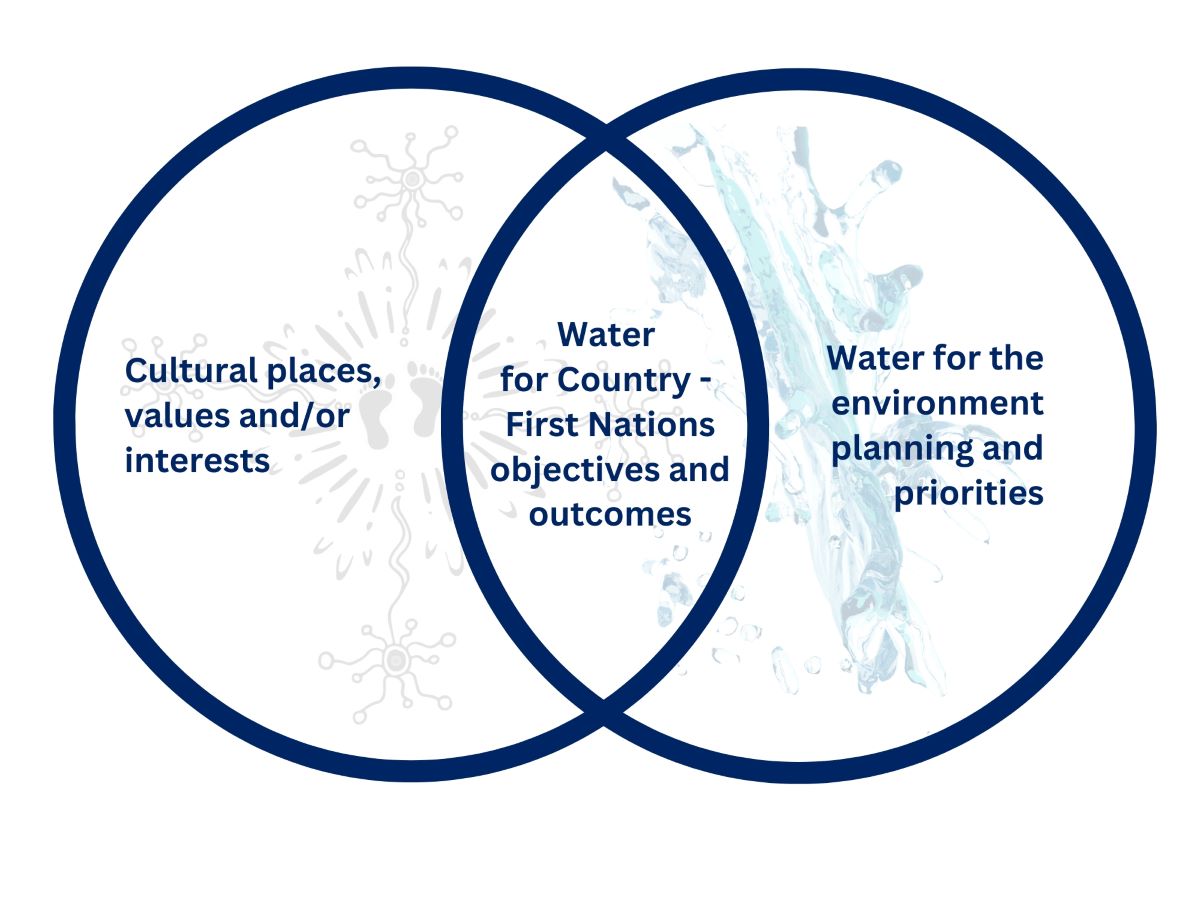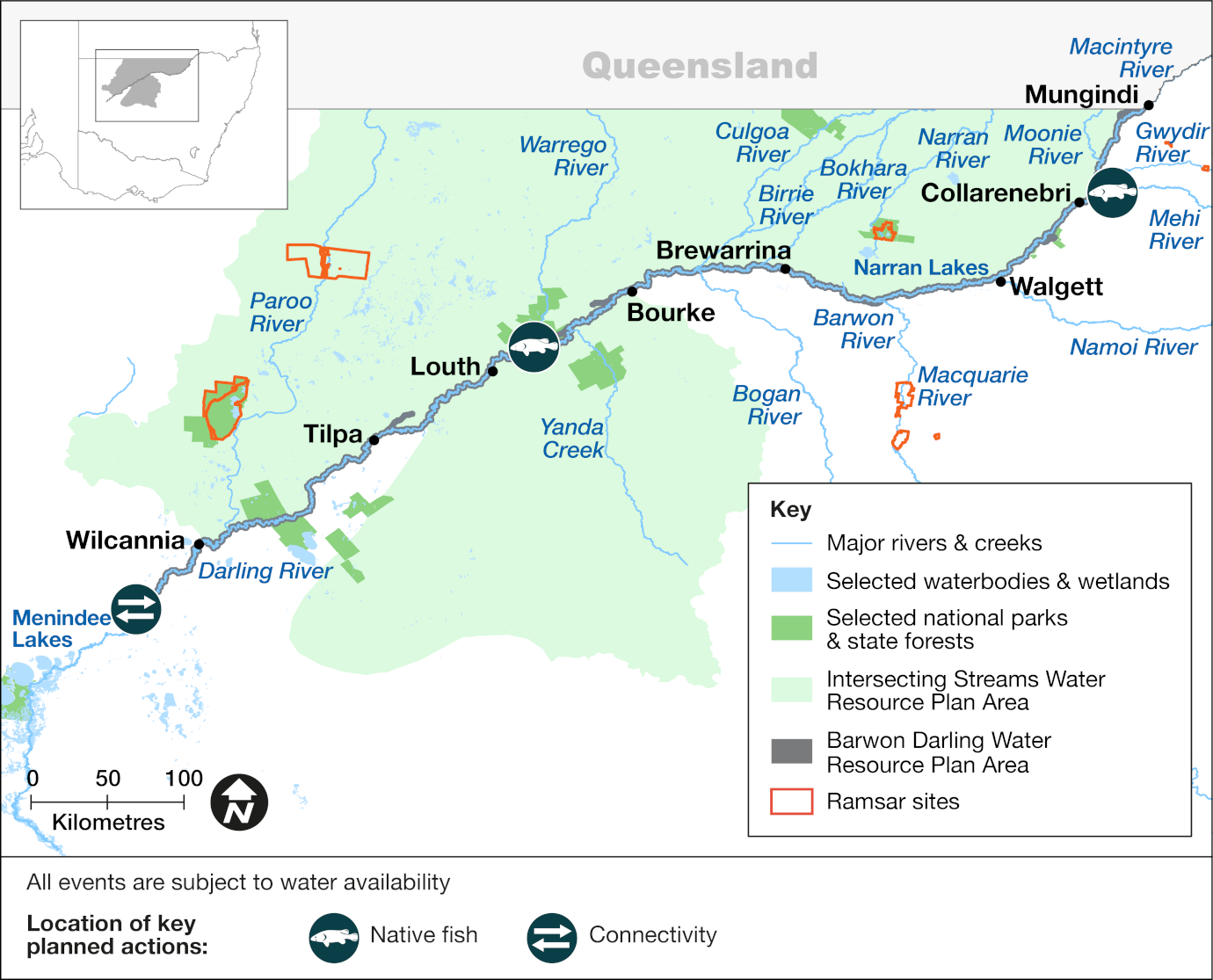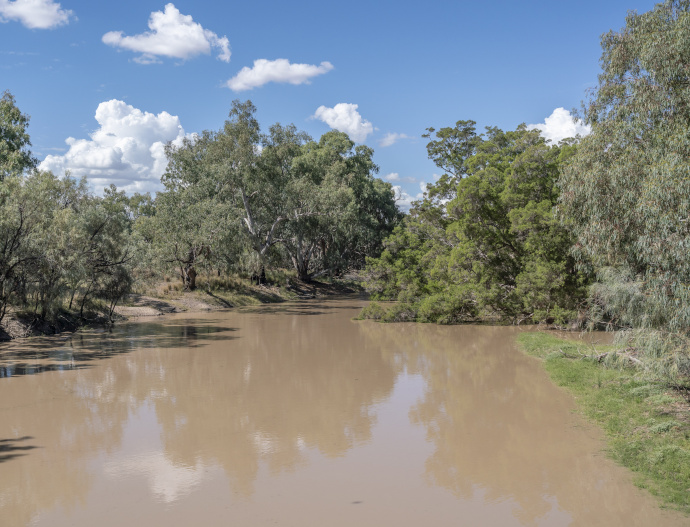Water that is allocated and managed specifically to improve the health of rivers, wetlands and floodplains is known as water for the environment.
Our environmental water management teams work with local communities, Aboriginal representatives, partner agencies, and other stakeholders to develop detailed annual plans for the use of water for the environment in each catchment, including how its use is prioritised.
Water for rivers and wetlands
The Barwon–Darling rivers rely on rainfall and inflows from tributaries to support river health. Many of the tributaries which flow into the system are regulated by dams, weirs and floodplain structures. This influences the ability of water managers to actively plan events to enhance river and wetland outcomes in this system.
Following significant rainfall between 2020 and 2022 flows rapidly receded in early 2023, with dry conditions until spring 2023. In late 2023 and early 2024, water managers protected water for the environment under New South Wales and Commonwealth licences.
Partnering with Aboriginal peoples

Environmental water managers have been working to support Aboriginal people’s priorities in water management.
Water for Country is environmental water use planned by the Department of Climate Change, Energy, the Environment and Water and Aboriginal people to achieve shared benefits for the environment and cultural places, values and/or interests.
In 2024–25, water managers will continue to work with Barkandji, Muruwari, Ngemba, Ngiyampaa, Euahlayi and Kamilaroi/Gomeroi Aboriginal people to identify possible co-cultural-environmental watering sites on the Baaka – Lower Darling River. This may include working with Aboriginal peoples to learn about the values of off-stream watering sites such as billabongs and wetlands.
Weather and water forecast
As of June 2024, the El Niño–Southern Oscillation outlook is neutral. That is, neither La Niña nor El Niño conditions are favoured as oceanic and atmospheric indicators have returned to neutral levels. International climate models suggest neutral El Niño–Southern Oscillation conditions will persist through the southern winter, but there are some signs that La Niña conditions could form later in the 2024–25 water year.
After experiencing wet conditions throughout 2021–22, rainfall began to subside in December 2022. Dry conditions continued until spring 2023. Despite sporadic rainfall events during spring and summer, 2 notable flow events occurred in the Barwon–Darling rivers in summer and autumn 2023–24, triggered mainly by flows from the Border, Moonie, Weir, and Culgoa rivers.
Natural inflows will likely decrease in the Barwon–Darling in early winter before the possibility of median rainfall. This presents opportunities for water managers to use held licenses to protect flows in the Barwon–Darling catchment.
Water managers have prepared annual watering plans that consider a range of weather and water availability scenarios. This is referred to as resource availability scenario planning.
Resource availability scenario
Current forecast: Dry to moderate
This table provides details about how we plan for different resource availability scenarios. Dry to moderate conditions are forecast for the Barwon–Darling catchment in 2024–25, which means water availability planning will follow the ‘dry’ and ‘moderate’ scenarios.
| Forecast | Main aim | Other aims |
|---|---|---|
| Very dry | Protect | Avoid critical loss Maintain key refuges Avoid catastrophic events |
| Dry | Maintain | Maintain river functioning Maintain key functions of high priority wetlands |
| Moderate | Recover | Improve ecological health and resilience Improve opportunities for plants and animals to breed, move and thrive |
| Wet to very wet | Enhance | Restore key floodplain and wetland linkages Enhance opportunities for plants and animals to breed, move and thrive |
Key planned actions
Native fish
As fish populations are still recovering from significant fish kills in the northern Basin and at Menindee in early 2023, a key priority is to support remaining stocks of native fish and provide opportunities for them to breed and disperse along the system. The goal is to maintain flows and support small fresh events to help supply food to native fish and other aquatic wildlife, including frogs.
Connectivity
Cease to flow conditions may return in 2024–25. A key priority will be maintaining low or base flows and providing small freshes. Under more moderate rainfall conditions and small freshes, consistent base flows are more likely.
Another priority is maintenance of connecting flows between the Barwon–Darling rivers and the Baaka – Lower Darling, to support the recovery of native fish populations. However, river connectivity is impeded by lack of fish passage downstream of Menindee main weir. Maintaining connection along the length of the river will require wet or moderate conditions across the northern Basin, which may become more likely should La Niña conditions develop.
Map of proposed annual priority targets in the water resource plan area 2024–25

Map of the Barwon-Darling catchment area showing priority targets for environmental water to be delivered to in 2024-25
The Department of Climate Change, Energy, the Environment and Water delivers water for the environment where and when it is needed to support the health and resilience of rivers and wetlands. We use the best available science, management expertise and experience to manage water across the landscape. This statement of annual priorities identifies the waterways and wetlands that are likely to receive water.
Our decision-making process considers:
- expected availability of water in the coming year
- conditions of the previous year
- current health of the plants and animals in these ecosystems.
Water for the environment delivers benefits for communities, rivers, wetlands and wildlife across New South Wales.
Healthy, connected rivers and floodplains are a focus for tourism, fishing, recreation and relaxation. Rivers carry water to our homes, schools, farms and businesses, and along the way, support countless species including native fish, waterbirds, frogs, plants and more.
Rivers and wetlands have great cultural and spiritual significance for Aboriginal people.
Water for the environment is a critical tool to maintain and enhance the rivers, wetlands and wildlife we all love.
Working with communities
Local communities are at the heart of everything we do.
We involve the broader community by holding site tours and forums, and online and in-person events. In catchments that have community-based environmental water advisory groups, our local water management teams consult with them regularly.
Environmental water advisory group members include local landholders, recreational fishers, Aboriginal people and local government representatives. Their advice informs the decisions made by our local environmental water management teams.
The Barwon–Darling catchment doesn’t currently have an environmental water advisory group, but the intention is to establish one.
Water licenced to the Commonwealth
| Source | Maximum volume available (megalitres) | Volume expected 1 July based on current forecast allocation (megalitres) |
|---|---|---|
| A class unregulated | 73 | Event dependent |
| B class unregulated | 16,060 | Event dependent |
| C class unregulated | 12,498 | Event dependent |
Water licenced to New South Wales
| Source | Maximum volume available (megalitres) | Volume expected 1 July based on current forecast allocation (megalitres) |
|---|---|---|
| A class unregulated | 191 | Event dependent |
| B class unregulated | 51 | Event dependent |
| Unregulated | 1,488 | Event dependent |
Notes: This is an indicative summary of expected volumes to be available. For further detail and information on available volumes you can contact the region via the Department of Climate Change, Energy, the Environment and Water on 1300 361 967.
1 gigalitre = 1000 megalitres; 2.5 megalitre = 1 Olympic swimming pool.
Water for the environment has been delivering outcomes for rivers, wetlands and wildlife for 30 years.
We deliver flows that:
- trigger native fish to breed and move
- support waterbirds to nest and feed
- connect rivers and floodplains
- water forests and floodplains
- allow plants to grow, flower and set seed
- create refuge during droughts
- enhance outcomes during wetter times
- release vital nutrients from the floodplain floor that underpin the aquatic food web.
It’s habitat restoration on a landscape scale.

Culgoa River in the Barwon-Darling catchment
More information on planned and past watering events
- Annual environmental water priorities in the Barwon–Darling Barwaan–Culliwatta–Baaka rivers 2023–24
- Annual environmental water priorities in the Barwon–Darling Barwaan-Baaka rivers 2022–23
- Barwon-Darling rivers: Annual environmental watering priorities 2020–21
- A year in the Barwon-Darling catchment: 2022–23
- A year in the Barwon-Darling Barwaan-Baaka catchment: 2021–22
- A year in the Barwon–Darling catchment: 2020–21